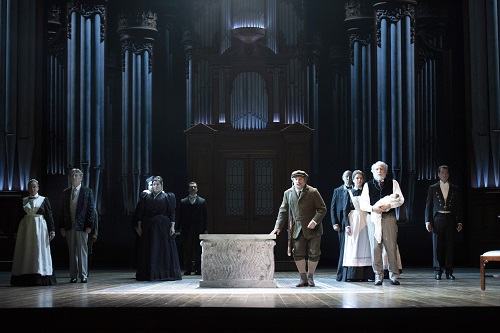 United Kingdom Glyndebourne Festival Opera 2018 [2] – Debussy, Pelléas et Mélisande: Soloists, Glyndebourne Festival Chorus, London Philharmonic Orchestra / Robin Ticciati (conductor). Glyndebourne Festival Opera, Sussex, 30.7.2018. (CC)
United Kingdom Glyndebourne Festival Opera 2018 [2] – Debussy, Pelléas et Mélisande: Soloists, Glyndebourne Festival Chorus, London Philharmonic Orchestra / Robin Ticciati (conductor). Glyndebourne Festival Opera, Sussex, 30.7.2018. (CC)

Cast:
Pelléas – John Chest
Mélisande – Christina Gansch
Golaud – Christopher Purves
Geneviève – Karen Cargill
Arkel – Brindley Sherratt/Richard Wiegold
Yniold – Chloé Briot
Doctor – Michael Mofidian
Shepherd – Michael Wallace
Production:
Director – Stefan Herheim
Designer – Philipp Fürhofer
Costumes – Anja Vang Kragh
Lighting – Stefan Herheim & Tony Simpson
Dramaturg – Alexander Meier-Dörzenbach
This Pelléas marks Stefan Herheim’s directorial debut for Glyndebourne. He has a stated intent to make people rethink familiar operas, as his Verdi Les vêpres siciliennes in 2017 at the Royal Opera attested: see review. Initially, this Pelléas was to have been set in a space station (an extension of his belief that, for this opera, one needs to step back, much as the characters on stage are often distanced from each other emotionally. It would have been, clearly, an idea alien to many). The space idea sadly rejected – it is intriguing, to say the least – Herheim moved an awful lot closer to home for inspiration. Just a few metres from the opera house itself, in fact, to Glyndebourne’s Organ Room, in a replica of which the entire drama is set, thanks to designer Philipp Fürhofer. The paintings we see on stage are locatable in the actual room, for example. And although perspective shifts through movable walls, the Organ Room is the space in which we stay. The water present in the story, and universal symbol symbol of the unconscious, is found through a trapdoor in the centre of the stage, but even that fluidity is hidden from us. Water, when suggested at all, is suggested via projected sparklings above a hole in the ground. At one point a bunch of somewhat merry Glyndebourne opera-goers turn up, in a gesture that smells a little of the tourists that invade the Egyptian ruins at the end of Philip Glass’ Akhnaten.
Symbols layer upon an already symbol-drenched score here. We see Christ with a lamb (think Glyndebourne sheep, obviously: a morphing of Jesus, the Lamb of God, and the perfect English pastoralism of the opera house, and referring to Arkel’s idea of Mélisande as something of a local Saviour herself, perhaps, ushering in a new and more hopeful era for the assembled characters). Cast members frequently put their hands in front of their eyes, simulating blindness, a metaphor for loss of clarity, perhaps; or perhaps we are all blind; or blindly led by an inevitability of fate.
The clean, straight lines of the organ room, however, create a striking dissonance with Debussy’s inspired, fluid writing. While one might hope that such dissonance is a fruitful and stimulating one, in reality the resulting incongruity is difficult to dislodge. Perhaps that discomfort is part of Herheim’s point, perhaps not, but the real issue is that it is difficult to enter Debussy’s impeccably manifested musical world, despite the miracles going on in the pit from the LPO under Robin Ticciati.
Early on we see a table holding a dead body (Pelléas?). Golaud is shown as a nasty piece of work from the start, his jealousy omnipresent rather than triggered by the ring saga. At several points he looks down from the organ console, observing. There’s some gratuitous and uncomfortable incest between Golaud and Yniold. Pelléas’ ghost has a part to play in the concluding scene.
We have a female Yniold, the fresh-voiced Chloé Briot. While trebles are a rarity to be cherished (Boulez used one in his CBS set), Herheim manages to get double-bubble in his reading, wherein Yniold can transform into a second Mélisande, complete with long hair. Although, in the spirit of ‘fluidity’ of production, that hair is here hardly the super-long variety the piece demands.

There are more surprises for the unsuspecting (the list is long) but the main point is that the concept feels tacked-on. The performance itself was another matter; it should be noted that Brindley Sherratt was vocally – if not bodily indisposed – and walked the part as Arkel, with Richard Wiegold singing from the side. Most impressive of all was Christina Gansch’s delicate Mélisande, perfectly judged vocally, flexible, light yet not insubstantial, a veritable glittering light in the Impressionist forest. Sorry, room. Her stage presence, too, was remarkable. Although I was massively taken by Purves’ Handel extravaganza at Milton Court with Archangelo in January, he seemed less at ease here at first as Golaud, his French not always idiomatic; it was only later we heard his full dramatic power. John Chest, an American baritone and finalist in the 2017 Cardiff Singer of the World, was a splendid Pelléas, able to project the impetuous nature of his character well. Karen Cargill was an impressive presence as Geneviève, her voice luscious, while Richard Wiegold sang Arkel with real confidence and heft (Sherratt mimed well onstage). Michael Wallace was an excellent Shepherd (dressed as a cleric, more Lamb of God analogy, the Lord is your shepherd, etc.?); Michael Mofidian was a fine Doctor.
I do wonder if a rematch might bring forth hidden depths. It will, certainly, bring forth more analogies, sleights and maybe just more plain battiness. It would also, though, offer another chance to revel in the superb performances from the members of the London Philharmonic Orchestra, the true heroes and heroines of the evening.
Colin Clarke
For more about GFO click here.
How interesting to read this review after reading MB on the Boulezian website.